Basic Obedience Training for Your Dog
One of your biggest jobs as a dog guardian is to keep your dog safe, and the best way to do this is to train your dog to obey the basic commands so he stays under your control at all times. The six basic obedience commands are sit, stay, heel, come, down (lie down) and off (don't jump up). This article will show you how to train your dog at home, without spending money on a professional training school.
First, some basic concepts. Your dog needs to know that you are the boss, not him. To accomplish this, you must use a firm voice when giving commands. Think of yourself as a Marine drill sergeant, not as a loving granny.
While training your dog, keep him on a short leash with a choker collar. Pull up firmly on the leash to tighten the choker, but don't go too far. You don't want the dog dangling from the end of the leash, and you don't want to damage his windpipe or vocal chords. Be sure to loosen the collar frequently so it doesn't stay perpetually tight around the dog's neck.
Always use the dog's name before you give a command. This will help you to get his attention and focus him on the task at hand.
Never, never, never hit your dog or scold him harshly. Many dogs rebel from rough training methods and refuse to perform the moves you are trying to teach. It is much better to reward good behavior with treats, praise, and attention than to punish poor behavior.
Dogs have a fairly short attention span. Your dog will learn faster if he is given short training sessions several times a day rather than long training sessions once a day. Try working with him for five minutes before work, then for ten minutes after work, and another ten minutes before bedtime. Make sure you reward his hard work with some playtime after each training session. At least throw a tennis ball for him a few times before packing it in. Schedule time for training every single day until you are confident your dog will obey your commands in any situation. This may end up being a life-long endeavor, but it pays big dividends in keeping your dog safe.
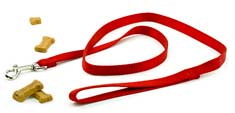
The only equipment needed for basic obedience training is a short (4 - 6 foot) leash, a choker collar, and very small pieces of dog treats.
The first command most dogs learn is SIT. Standing in front of your dog, hold a treat above his head and slightly behind the head so he has to look up and back to see it. In a firm voice, say [dog's name] SIT. While you are saying this, push on his rump with your other hand. As soon as he sits, immediately give him the treat and pet him, telling him, "Good sit!" At this point, don't worry if your dog jumps up the minute his tail end hits the floor; you are only worried about the fact that he does perform the sit right now.
Once your dog has mastered sit, you can begin progressing to STAY. Put your dog in the sit position as above. Praise him for sitting, but don't give him the treat immediately. If he gets up, repeat the command of [dog's name] SIT, and wait for him to sit back down. Repeat this procedure until you can get the dog to reliably sit for at least five seconds.
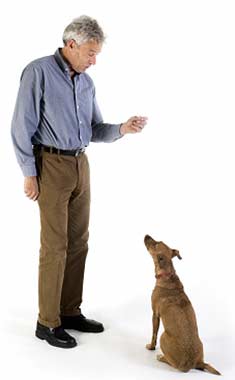
When he is able to do this, you are ready to lengthen the amount of time he can stay seated by using the STAY command. This is most easily accomplished without a treat, as the treat tends to excite the dog and you want him to be calm. Put your dog in a sit position without using a treat. Your dog won't know you don't intend to treat him, so he will sit.
Place your hand in front of the dog's face, palm facing the dog, and say [dog's name] STAY! Take one step backwards. If the dog doesn't follow you, tell him "Good stay!" then take a treat from your pocket and reward him. If the dog does follow you, step back up to him, put him in a sit position and try again. Once the dog stays when you take one step away from him, start moving further away before you treat him. Eventually, you should be able to get at least six feet from the dog with him sitting there waiting for you. Once the dog is able to stay with you backing away from him, try turning and walking away while facing away from him. He must be capable of staying put, even when you are not paying attention to him.
In conjunction with teaching the stay command, you will also be working on the COME command. Once you have walked away from the dog while he is at stay, you will call your dog to come to you for his treat. When you are satisfied that he has stayed for the length of time or for the distance you are trying to attain, simply look at the dog and say [dog name] COME! Since you are holding a treat at this point, your dog will not hesitate to come to you. Reward him with the treat and tell him "good come!"
The three commands above can be taught anywhere, indoors or out. The next command, HEEL, must be taught in the context of a walk. The goal is to have your dog walk calmly by your side, with his head beside your right knee. The dog always walks on your left side, for no particular reason other than tradition.
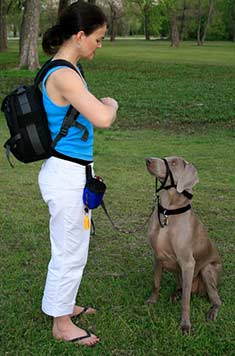
When you are walking your dog, particularly if he is stronger than you, do not wind the leash around your hand. If the dog takes off, you will not be able to get the leash free from your hand in time to prevent yourself from falling. Many people have ended up with broken arms and collarbones from trying to control an out-of-control dog on a walk. It's far better to go back home, get the car, and find the dog than to have to go to the hospital because you didn't let go of the leash.
Once you have the dog thoroughly trained to heel, you won't need to worry about this as much, but as you are beginning training, make it a habit to simply fold the leash up into your right hand so that only as much leash is loose as is required to thread through your left hand and fall to the top of the dog's collar. The rings on the choker should be on top of the dog's neck, and the leash should go straight up through your left hand, across your body, and into your right hand.
You should feel no need to let your dog set the pace. Begin walking at a pace that is comfortable for you. Give the command [dog's name] HEEL! If the dog gets ahead of you, give a quick jerk on the leash to tighten up the choker collar. If the dog wants to pull you along, simply stop walking. The dog will stop when his choker becomes tight around his neck. When the dog stops, reel him in and position him back on your left side.
When the dog walks sedately by your side, take a short reward break. Stop walking, jerk up on the choker (if necessary) and give the command [dog's name] SIT! Reward him with a treat from your pocket and give him lots of praise. The goal is to get your dog to reliably walk by your side without your having to jerk on the leash. When you stop walking, he should automatically sit and stay until you begin walking and give the heel command again.
By the time your dog has learned these four commands, he should have a pretty good idea that it is to his benefit to follow your orders. He should realize that obedience allows him to get treats and praise, while disobedience results in a tight, uncomfortable collar. Now, he is ready to learn the hardest command: DOWN. Lying down puts a dog in a submissive position, and most dogs do not like being made to do that.
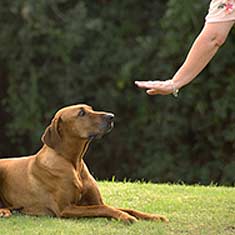
Put your dog in a sit position, then with a treat in your hand, pat the ground in front of the dog. If needed, you can bump the backs of his front legs with your other hand to encourage him to stretch them out. Reward the dog for each progressive step he takes towards getting his body completely down on the ground. When he finally makes it all the way down, lavish him with praise and an extra couple of treats.
The last command, OFF, is important because it keeps your dog from eating you out of house and home. Large dogs, in particular, are known for counter surfing; no roast or casserole left on the drainboard is safe! In addition, the OFF command keeps your dog from jumping up on visitors to your home, which can enhance the safety of your guests.
If you can catch the dog before he actually jumps, but when he has that look in his eye, give the OFF command to try to distract him from completing the thought of getting up on his hind legs. Take an empty soda pop can and put a few pennies in it. Shaking the can will also serve as a good distraction to the dog.
If you miss the cues and the dog is already up on something, jerk on the dog's choker and give the command [dog's name] OFF! Reward him for putting all four feet on the floor, or jerk his collar again, this time a little harder to make him obey.
To reinforce the OFF command, you may have to set up a little planned conspiracy against your dog. Ask a friend or neighbor to help you by coming to your door and knocking. Approach the door, holding onto your dog's choker. As you open the door, say the [dog's name] OFF, and keep a firm hold on his collar to prevent him from even starting to jump. Reward him for obeying you, even though you really gave him no choice in the matter. Repeat this several times a day, and he should begin to get the idea.
If you absolutely cannot get your dog to keep all four feet on the floor, you must keep him out of your kitchen when you are cooking by using a baby gate. To solve the problem of jumping up on visitors, you may want to designate a spot where the dog must stay when the door is opened.
For example, if your dog crate is near the foyer of your house, you may want to make the dog stay in the crate when your doorbell rings. Again, enlist a friend's help to ring your doorbell, then point to the crate and tell your dog, [dog's name] CRATE! At first, you may have to lead him to the spot, and put him in a sit/stay. Eventually, you should be able to get him to go to his spot without help.
No matter what you are training your dog to do, remember that rewards work better than punishments. The bigger the reward, the more likely your dog is to perform, and the biggest reward of all for your dog is the play time you give him at the end of each session. Even if he only did one thing right during the training session, don't forget to end with some play time so he knows that training is a fun and rewarding experience! Each dog learns at his own pace, and you must commit to spending adequate time training your dog to meet his individual needs. Don't give up. Your dog will learn if you are patient and consistent with him.
Doggies Den: Latest Articles
 Homemade Thanksgiving Treats for Your Dog
Homemade Thanksgiving Treats for Your Dog
NUTRITION We all want to include our dogs in our holiday celebrations, but hopefully, you're aware that sharing table scraps with your dog isn't always the best idea.
 Keeping Your Dog Safe during the Summer Months
Keeping Your Dog Safe during the Summer Months
HEALTH Summer is coming on fast, so it’s time to plan how you will keep your dog safe and healthy through the lazy, carefree, warm days.
 Vaccination Time Again-Keeping Your Puppy Healthy
Vaccination Time Again-Keeping Your Puppy Healthy
DOG HEALTH So you have your new puppy picked out. There are quite a few shots, treatments and examinations that will keep the newest member of your family healthy.
 Canine Thanksgiving Feast
Canine Thanksgiving Feast
NUTRITION With the wide variety of food at Thanksgiving dinner, chances are you'll want to give your dog something special, too. If you're contemplating what to feed your dog for the holiday, here is a guide to a great Canine Thanksgiving Feast.
 Dog Walking Tips Every Owner Should Know
Dog Walking Tips Every Owner Should Know
DOG FUN Walking your dog is not only crucial to keeping him healthy and happy, it strengthens the bond between your canine friend and his caregiver. There are a lot of obstacles out there. Don’t forget these simple tips to keep your walk fun and safe in the outside world.
 The Benefits of Physiotherapy for your Dog
The Benefits of Physiotherapy for your Dog
HEALTH The same techniques that physiotherapists use to treat a variety of injuries and conditions in humans have been adapted to suit animals with great success. Family pets, show dogs, and working dogs can all benefit greatly from physiotherapy. Dogs whose activities involve a lot of agility are especially susceptible to the types of problems that physiotherapy can address.
 The Decision- Adding a Dog to Your Family
The Decision- Adding a Dog to Your Family
FIRST TIME OWNERSBringing a dog into your family is a decision where many people don’t realize it’s magnitude until after they have the dog. There are a number of things that you need to research before you decide to purchase a dog, and it starts right in your own home.
 Bringing Your Dog Into Your New Baby's Life
Bringing Your Dog Into Your New Baby's Life
HEALTH Many believe that a dog and a new baby cannot happily coexist, so therefore the dog has to go. This is not necessarily the case. A new baby does not mean you have to abandon your dog.

Doggies Den:
Most Popular Articles

Dog Pregnancy Symptoms
HEALTHIf you suspect your dog might be pregnant, check out part one in this series on pregnant dogs, where we cover pregnant dog symptoms.

Dog Birth
HEALTHIn the third article of our dog pregnancy series, we look at the wonderful, but messy, process of bringing newborn puppies into the world.

Indoor Dog Potties
DOG PRODUCTSIt's been a long day at work. You were so busy, you didn't even take time to eat a sandwich, let alone run home to let your dog out. You're on your way home, knowing the poor dog is crossing his or her legs by now, when your car breaks down, delaying you even further. Can't somebody make this easier?
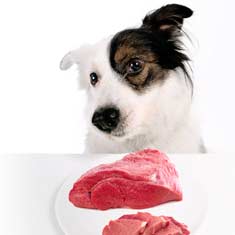
Your Dog’s Digestive System
PHYSIOLOGYEver wonder why your dog eats so fast? Or why he eats gross things? Or why he gets sick to his stomach? Or why his waste stinks so bad? Some of these things are normal, some are not.

Canine Respiratory System
BREATHINGThe basic function of your dog's respiratory system is to bring oxygen in to and remove carbon dioxide from the body. Knowing the symptoms of respiratory diseases can help you help your stay healthy.
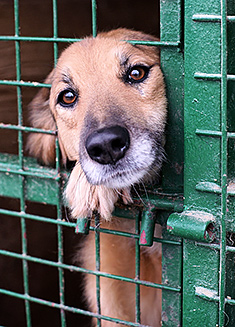
Shelter Dog Adoption Tips for Success
ADOPTION Are you intimidated by the prospect of "rescuing" a dog from a shelter? One reason that you may be wary of adopting a dog from a shelter is not knowing how to choose. Adopting a dog from a shelter can be a rewarding process, if you're prepared to do a reasonable amount of research.

Canine Urinary Tract Infections
SYMPTOMS AND TREATMENTDoes your dog seem to be having trouble relieving his or her bladder? Learn how to recognize the signs of urinary tract infections and how to treat them before they spread.

What to do for Dog Diarrhea
SYMPTOMS AND REMEDIESIf you have dogs in your house for any length of time, you have likely experienced at least one bout of dog diarrhea. Beyond the pain in the tuckus involved in cleaning up the mess, you should know what causes diarrhea, and when it's important to see the vet.
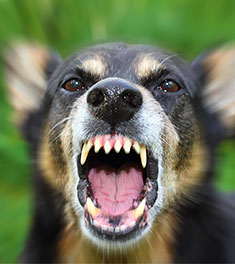
What to do for a Dog Bite
DOG BEHAVIOR Getting bitten by a dog can be scary, and you may be tempted to run around in circles for a while, trying to figure out what to do. Here's our guide to help you manage the situation.

Top Ten Tips for Living with a Senior Dog
DOG HEALTH Bringing home a new puppy is so exciting, but it doesn’t take all that long for your exuberant puppy to grow into a senior dog who may have special needs. Here are the doggies.com top ten tips for taking care of your companion who has been with you through so much.
